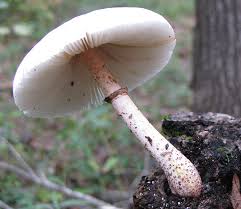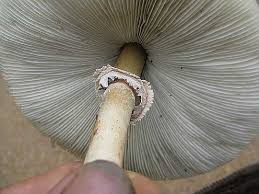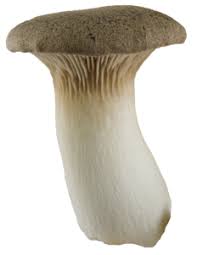Mushroom stem are the elongated, cylindrical, and often solid parts of the mushroom that support the cap and connect it to the mycelium, which is the vegetative part of the fungus that grows underground or within the substrate. The stem’s appearance, size, and texture can vary significantly depending on the species of mushroom.
Mushroom stems can be short or long, slender or thick, and may have different shapes, such as cylindrical, club-shaped, or bulbous. The size of the stem also varies depending on the species, ranging from just a few centimeters to several inches in length.
The texture of mushroom stems can be smooth, rough, fibrous, or even scaly, depending on the mushroom type. Some mushroom stems may feel brittle, while others can be flexible and pliable.
The color of mushroom stems is often similar to or slightly lighter than the color of the cap. However, in some species, the stem may have distinct color variations or patterns.
Some mushrooms have a ring-like structure called an annulus or veil on the stem, which is a remnant of the partial veil that covers the gills when the mushroom is young. As the mushroom matures, the veil may break, leaving the ring on the stem.
The bottom part of the stem, known as the base, is usually connected to the mycelium, which is a network of fine, thread-like filaments that form the main body of the fungus.
The edibility of mushroom stems can vary widely. In some species, the stems are edible and have a pleasant taste and texture. In other cases, the stems may be tough, woody, or even toxic, making them inedible or unpleasant to eat.
It is essential to identify mushrooms accurately before consuming them, as some species can be poisonous and even deadly. If you are unsure about the edibility of a particular mushroom species, it is best to seek guidance from an experienced forager or mycologist.
Economic Importance, Uses, and By-Products of Mushroom Stem

The stems are generally considered to have less commercial value compared to the caps due to their fibrous and less flavorful nature. Below are the its basic economic importance;
1. Food Processing and Value-Added Products: Mushroom stems can be used in various food processing industries to create value-added products. They may be used as a base for soups, sauces, and stocks, where their flavor and nutritional properties contribute to the overall taste. Additionally, mushroom stems can be processed into powders, extracts, or concentrates to be used as natural flavorings or additives in the food industry.
2. Animal Feed and Fertilizer: Mushroom stems, being rich in fiber and nutrients, can be used as animal feed, especially for ruminants like cattle. They can be dried, ground, and mixed with other feed ingredients to provide a nutritious and cost-effective option for livestock. Furthermore, mushroom stems can be composted and used as organic fertilizer to enhance soil health and plant growth.
3. Biodegradable Packaging and Materials: The fibrous nature of mushroom stems makes them suitable for biodegradable packaging materials. Researchers have been exploring the use of mushroom-derived materials, including stems, to create eco-friendly packaging alternatives that can replace non-biodegradable plastics.
4. Pharmaceutical and Nutraceutical Applications: Mushrooms are known for their medicinal properties, and while the caps often receive more attention, the stems can also contain beneficial bioactive compounds. Extracts from mushroom stems may have potential applications in the pharmaceutical and nutraceutical industries for their antioxidant, anti-inflammatory, and immune-boosting properties.
Read Also : Economic Importance, Uses, and By-Products of Mushroom Annulus
5. Bioenergy and Biodegradable Plastics: Mushroom stems, like other lignocellulosic materials, can be utilized for bioenergy production. Through processes such as anaerobic digestion or pyrolysis, mushroom stems can be converted into biogas, biofuels, or other forms of renewable energy. Moreover, researchers have been investigating the use of mushroom stem residues in the production of biodegradable plastics and bio-based polymers.
6. Cosmetics and Personal Care Products: Mushroom extracts have been used in the cosmetics and personal care industry due to their potential skin-enhancing properties. While the focus has largely been on mushroom caps, there could be opportunities to explore the use of mushroom stems in skincare products as well.
7. Bioremediation and Environmental Applications: Mushroom stems, like the rest of the fungus, have a remarkable ability to break down and absorb various environmental pollutants. They can be used in bioremediation efforts to clean up contaminated soils or water bodies, providing an environmentally friendly and cost-effective solution.
8. Paper and Textile Industry: Mushroom stems’ fibrous nature makes them a potential raw material for paper production. By pulping and processing mushroom stems, they can be used in the paper and packaging industries. Additionally, the textile industry has shown interest in using mushroom-derived fibers as a sustainable alternative to conventional textiles.
9. Cultivation Substrate and Agricultural Uses: Mushroom stems can be reused as a substrate for growing other mushrooms. After harvesting the fruiting bodies, the remaining substrate (which includes stems) can be used to cultivate other mushroom species, reducing waste and optimizing resource utilization. Moreover, compost made from mushroom stems can be beneficial for improving soil fertility and structure in agriculture.
It’s essential to emphasize that the economic viability and applications of mushroom stems may vary depending on factors such as local market demand, technological advancements, and research developments. As the sustainable and eco-friendly industries continue to grow, the utilization of mushroom stems and other agricultural by-products may gain more attention and commercial value.
If you are considering specific applications of mushroom stems or looking for up-to-date information, I recommend consulting experts in mycology, biotechnology, or agricultural sciences who are knowledgeable about the latest developments in this field.
The Products and By-products That Can Be Derived From Mushroom Stem

Mushroom stems, also known as stipes, are the elongated parts of the mushroom that support the cap. While the cap is commonly used for culinary purposes, mushroom stems also have several potential uses and by-products. Here are some products and by-products that can be derived from mushroom stems:
1. Mushroom Powder: Mushroom stems can be dried and ground into a fine powder. This mushroom powder can be used as a seasoning or flavor enhancer in various dishes, such as soups, stews, sauces, and gravies. It provides an earthy, umami-rich taste to the food.
Example Process: Wash the mushroom stems thoroughly to remove any dirt or debris.
Cut the stems into small pieces and dry them in a food dehydrator or an oven set to a low temperature.
Once the stems are completely dry, grind them into a powder using a blender or a spice grinder.
Store the mushroom powder in an airtight container to maintain its flavor and shelf life.
2. Mushroom Broth: Mushroom stems can be used to make a flavorful mushroom broth. The broth can be consumed as a beverage or used as a base for various recipes, such as risottos, sauces, and soups.
Example Process: Wash the mushroom stems to remove any dirt.
Chop the stems into smaller pieces.
In a pot, add the chopped mushroom stems, water, and optional seasonings like onion, garlic, and herbs.
Simmer the mixture on low heat for an extended period (usually 1-2 hours) to extract the flavors from the stems.
Strain the broth to remove the solids, and it’s ready to use.
Read Also : Economic Importance, Uses, and By-Products of Mushroom Pores
3. Mushroom Extracts: Mushroom stems can be utilized to produce concentrated extracts, which are used in supplements and traditional medicine due to their potential health benefits. Certain mushroom varieties, such as reishi, chaga, and shiitake, are particularly popular for their medicinal properties.
Example Process: Clean the mushroom stems and chop them into small pieces.
Extract the beneficial compounds by immersing the chopped stems in alcohol or water for a period (days to weeks).
Strain the liquid to obtain the mushroom extract, which can be further concentrated if desired.
4. Compost and Fertilizer: Mushroom stems can be composted, contributing to nutrient-rich compost that can be used to fertilize gardens or agricultural fields. The compost helps improve soil structure and fertility, promoting healthier plant growth.
Example Process: Collect the mushroom stems and combine them with other organic materials like vegetable scraps, coffee grounds, and yard waste in a compost bin.
Turn the compost regularly to ensure proper aeration and decomposition.
After several weeks to months, the compost will be ready to use as a natural fertilizer for plants.
5. Animal Feed: Mushroom stems can serve as a nutritious component in animal feed formulations, contributing to balanced diets for livestock and poultry.
Example Process: After harvesting the mushroom caps, the stems can be collected and dried.
The dried stems can then be ground and incorporated into animal feed preparations, considering the nutritional requirements of the specific animals.
6. Mushroom Fiber and Biodegradable Materials: Mushroom stems contain chitin, a fibrous substance found in the cell walls of fungi. Chitin is an abundant natural polymer and can be extracted from mushroom stems to produce mushroom fiber. This fiber can be used in various applications, including biodegradable packaging materials, sustainable textiles, and even as a reinforcement material in composite materials.
Example Process: Harvest the mushroom stems and remove any remaining mushroom caps or debris.
Process the stems to extract the chitin, which involves removing proteins and other impurities.
The extracted chitin can then be processed into mushroom fiber for various applications.
7. Biofuel Production: Mushroom stems, along with other agricultural and forestry residues, can be utilized as feedstock for biofuel production. Through processes like anaerobic digestion or fermentation, mushroom stems can be converted into biogas, bioethanol, or other biofuels.
Example Process: Collect mushroom stems along with other biomass materials.
Process the stems to break down the complex carbohydrates into fermentable sugars or convert them into biogas through anaerobic digestion.
8. Medicinal Mushroom Capsules and Supplements: While mushroom caps are commonly used for culinary purposes, the stems can also be utilized to produce medicinal mushroom capsules and supplements. Certain mushroom species, like lion’s mane and turkey tail, are known for their potential health benefits and are used in traditional medicine.
Example Process: Harvest the mushroom stems from the selected medicinal mushroom species.
Dry and grind the stems to a fine powder.
Encapsulate the powdered mushroom stems to create convenient and standardized doses for use as dietary supplements.
9. Mushroom Stem Tea: Dried mushroom stems can be used to make mushroom stem tea, which may have a milder flavor compared to teas made from whole mushrooms.
Example Process: Dry the mushroom stems thoroughly to remove moisture.
Crush the dried stems into smaller pieces.
Steep the crushed stems in hot water to create a flavorful tea.
10. Bioremediation: Mushroom stems have been used in bioremediation processes, where they help break down and remove pollutants or toxins from the environment. Some mushroom species have the ability to absorb and degrade contaminants, making them useful in cleaning up polluted soil and water.
Example Process: Plant mushroom stems in contaminated areas or mix them with contaminated soil.
Allow the mushrooms to grow and process the pollutants, breaking them down into harmless substances.

The versatility of mushroom stems offers numerous possibilities for their use as valuable products and by-products, promoting sustainability and reducing waste in various industries. However, it’s important to remember that some applications, especially in the realm of biofuels and medicinal supplements, require specialized knowledge and processing to ensure safety and effectiveness. Always consult with experts in the relevant fields before attempting large-scale production or commercial use.
Read Also : Comprehensive Fish Farming Guide
